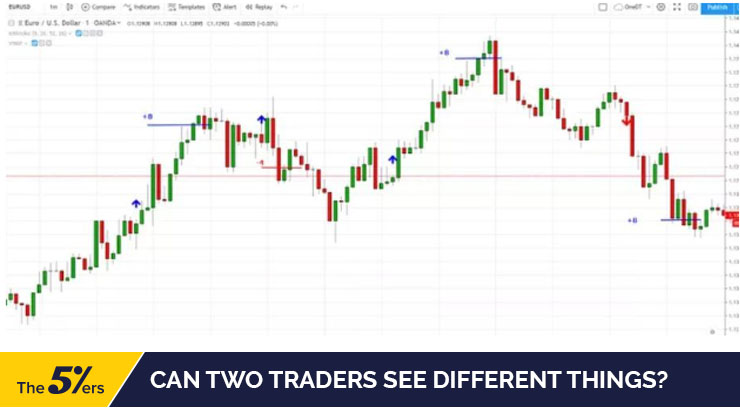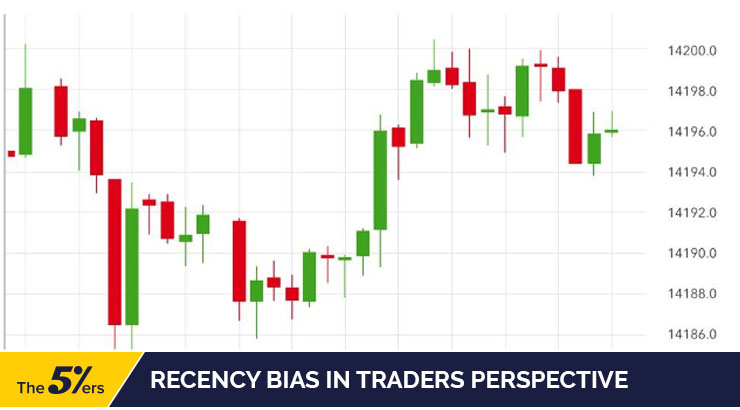Learn Why Traders Can See the Same Chart Differently
Trader’s Perspective Have you ever witnessed a situation in which two forex traders interpret the same chart in an entirely different way? If so, you’ve seen a prime example of how two people can look at the same exact thing and see different things. This is often referred to as the trader’s “perspective” or “perception.” […] The post Learn Why Traders Can See the Same Chart Differently appeared first on The5%ers | Funding Traders & Growth Program.


Trader’s Perspective
Have you ever witnessed a situation in which two forex traders interpret the same chart in an entirely different way? If so, you’ve seen a prime example of how two people can look at the same exact thing and see different things. This is often referred to as the trader’s “perspective” or “perception.”
While we could debate endlessly about which trader’s perspective is correct (and believe me, traders do debate this endlessly), that’s not the goal of this post. On the contrary, we just want to discuss this interesting phenomenon to learn why it occurs in the first place. So, why can two traders look at the same chart and see different things?
Keep reading to figure it out!

They Use Different Trading Strategies
Factor number one has to do with the trading strategies that each trader uses. Some traders are what we call “traditionalists.” They tend to rely mostly on technical analysis, utilizing things like support and resistance levels, Fibonacci retracements, moving averages, and other similar indicators.
On the other hand, there are also traders who prefer to follow trends. These types of traders are often referred to as “trend followers.” As you can probably guess, they rely less on technical analysis and instead focus on identifying and following trends. The point is that the type of strategy a trader uses will likely impact how they see a given chart.
For example, a traditionalist might look at a chart and see a clear uptrend. However, a trend follower might see the same exact chart and interpret it as being in a consolidation phase before potentially resuming the downtrend. As you can probably imagine, this difference in perspective can lead to entirely different trading decisions.
Recency Bias is a Common Cause Of Trader’s Perspective
Another factor that can impact a trader’s perspective is something called recency bias. This refers to the human tendency to place more emphasis on recent events than on events that occurred in the past.
For example, suppose you’re considering investing in a new company. You might be more likely to invest if the company’s stock has been increasing steadily over the past few months. However, this doesn’t necessarily mean that the company is a good investment; the stock could just as easily fall in the future.
The same is true in the world of forex trading. Traders who are influenced by recency bias might be more likely to buy a currency if it has been rising in value recently, regardless of whether or not it is actually overpriced. In general, it’s important to be aware of recency bias and try to make decisions based on all available information, not just the most recent data points.

Traders May Have Different Risk Profiles
Another thing that can impact a trader’s perspective is their risk profile. Some traders are more risk-averse than others, meaning that they are less willing to take on trades with a high potential for loss. Other traders are more risk-seeking, taking on trades with a higher potential for loss in hopes of achieving a bigger return.
Risk and return are two sides of the same coin; you can’t have one without the other. This means that traders with different risk profiles will likely see the same chart differently.
For example, a risk-averse trader might look at a chart and see a lot of potential for loss. On the other hand, a risk-seeking trader might look at the exact same chart and see a lot of potential for gain. It doesn’t take a genius to conclude that such differences will lead to opposing trade-related decisions.
Traders May Have Contrasting Emotional States
Another factor that can impact a trader’s perspective is their emotional state. Some traders are very emotionally invested in their trades, while others take a more detached approach.
For example, a trader who is feeling anxious about a trade might be more likely to exit the trade prematurely, even if there is still potential for profit. On the other hand, a trader who is feeling confident about a trade might be more likely to hold onto the trade for too long, even if the market is starting to turn against them.
Of course, emotions are not always bad; they can actually be helpful in some cases. For example, a trader who is feeling confident about a trade might be more likely to take on additional risk and potentially achieve a higher return. However, it is important to be aware of how your emotions can influence your trading decisions.
Pros And Amateurs Have Different Perspectives
One final factor that can impact a trader’s perspective is their experience level. Novice traders are more likely to make mistakes, such as buying a currency when it is overpriced or selling a currency when it is underpriced.
On the other hand, experienced traders are more likely to have a better understanding of the market and make trades that are more likely to be profitable. Of course, even experienced traders can make mistakes; no one is perfect. However, the difference in experience can still lead to contrasting perspectives.
Trader’s Perspective Summary
In conclusion, there are many factors that can impact a trader’s perspective. Some of these factors, such as recency bias and emotional state, are outside of the trader’s control. But a few other factors, such as risk profile and experience level, are within the trader’s control.
It is important to be aware of all of these factors and how they might influence your trading decisions. By doing so, you can make sure that you are making the best possible decisions for your trading strategy.
Author Bio
Charlie Svensson is a fast and engaging freelance writer who works for the college paper help agency. He is a master of finance-related content writing and blogging. Besides that, Charlie likes writing about education, social media, marketing, SEO, motivation, and self-growth.
 If you want to receive an invitation to our live webinars, trading ideas, trading strategy, and high-quality forex articles, sign up for our Newsletter.
If you want to receive an invitation to our live webinars, trading ideas, trading strategy, and high-quality forex articles, sign up for our Newsletter.
 Click here to check our funding programs.
Click here to check our funding programs.
 Don’t miss our Forex Trading Ideas.
Don’t miss our Forex Trading Ideas.
Follow us:  YouTube
YouTube  Linkedin
Linkedin  Instagram
Instagram  Twitter
Twitter  TradingView
TradingView
The post Learn Why Traders Can See the Same Chart Differently appeared first on The5%ers | Funding Traders & Growth Program.








